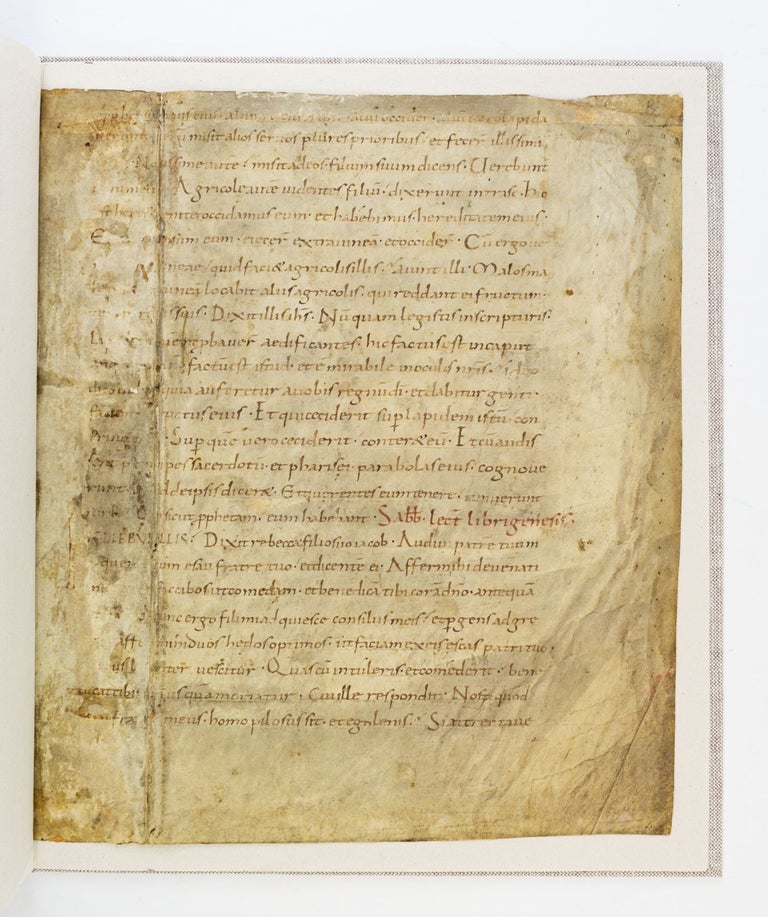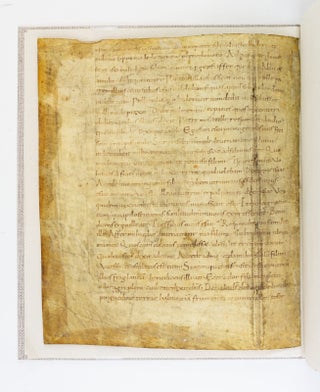WITH READINGS FROM MATTHEW 21:35-46 AND GENESIS 27:6-28.
(Probably Germany: third quarter of ninth century). 285 x 245 mm. (11 1/4 x 9 3/4"). Single column, 25 lines in a Caroline minuscule book hand.
Tipped into a paper folder and presented in a tan cloth binding, with ink notation on spine and a small sticker on upper cover. Rubrics in red. Front pastedown of folder with the bookplate of the Schøyen collection. With several pages of typed and handwritten notes, including Bernard Rosenthal's cataloguing and a copy of a letter from Bernhard Bischoff to Rosenthal concerning the dating of the leaf. ◆Recovered from a binding and thus with some expected browning, staining, and wrinkling, a long vertical fold through the text touching a couple letters of each line, recto with the first few words of each line roughened and somewhat obscured, a couple of other words a bit hard to make out, but the vast majority of text very legible, with fore and tail margins very ample, and, in all, quite a good specimen representing a remarkable survival.
Featuring a lovely Caroline miniscule hand, this very early leaf from a Lectionary may have been made for the use of a particular church or individual, and comes with recent distinguished scholarship and provenance. Although the text here contains familiar passages from the Old and New Testaments, their juxtaposition in this context presents a bit of a conundrum: as the enclosed cataloguing explains, the story of the wicked husbandmen from Matthew followed by the story of Esau surrendering his birthright to Jacob from Genesis "is an irregular and indeed unrecorded liturgical sequence of texts and suggests that this particular collection of lections was compiled for a particular church or private chapel." It is also possible that the Lectionary was made for the use of an individual (rather than an institution) with certain needs or preferences—perhaps a scholar or theologian, or even a Carolingian nobleman, many of whom were literate and educated. The hand here is an excellent example of the legible and elegant Caroline minuscule that dominated Western Europe in this period; distinctive letter forms include clubbed ascenders (such as on the letters "b," "d," and "l"), a long "s" with the shaft on the line, and the use of the ampersand as a general abbreviation for the letters "et" occurring anywhere in a word (for example, "conter&" for "conteret"). Termed the "integrated ampersand," this usage is especially characteristic of Caroline minuscule manuscripts of the late eighth and ninth centuries. Our leaf comes with bookseller Bernard M. Rosenthal's catalogue description, noting that it was "Purchased from Schab, New York, Feb. 1969." William H. Schab was a book and art dealer in the firm of Gilhofer and & Ranschburg in Vienna before fleeing Austria in 1938 and settling in New York, where he founded his own business. Also included here is a copy of a handwritten note regarding the date of the present leaf from renowned paleographer Bernard Bischoff. The leaf was also featured in Quaritch's 1991 catalogue 1147, Bookhands of the Middle Ages, V (no. 25.5), and was until recently part of the Schøyen Collection (their MS 623). Four additional pages of cataloguing are also included here. Despite having been used as binding scrap at some point in its life, this leaf is very well preserved, with no words lost from trimming, with distinctly visible ink, and in a clear and very pleasing hand. (ST17766)
Price: $25,000.00


